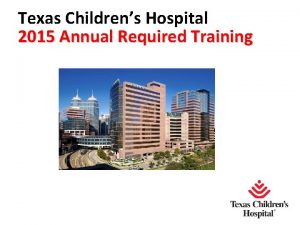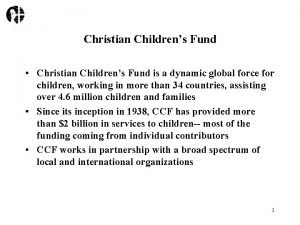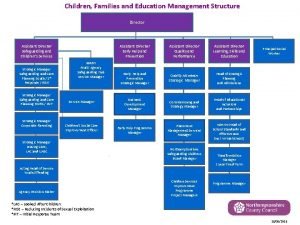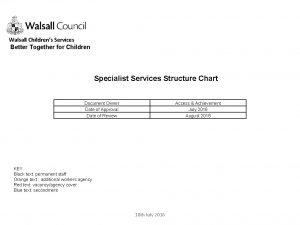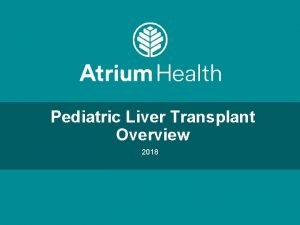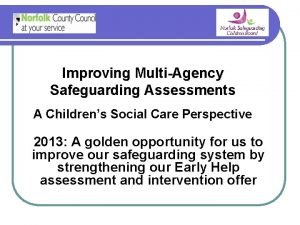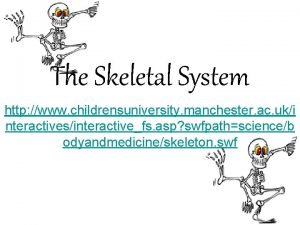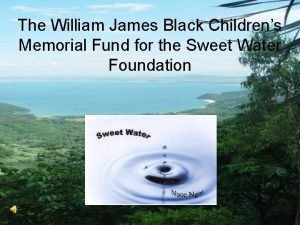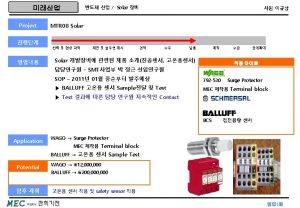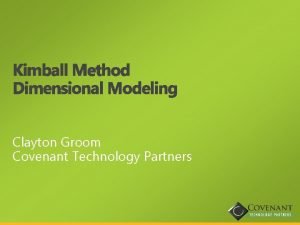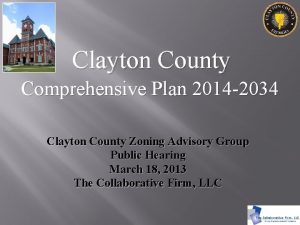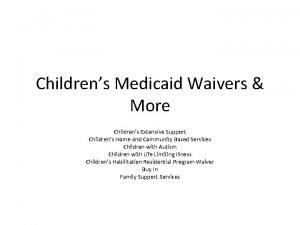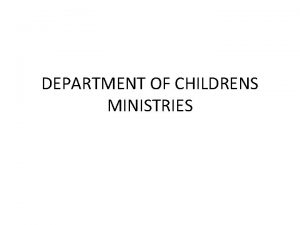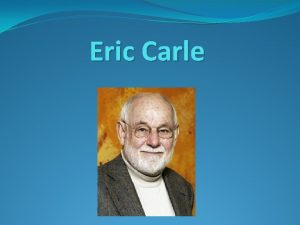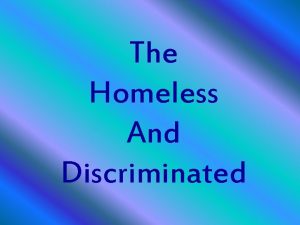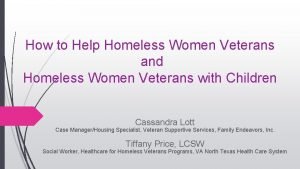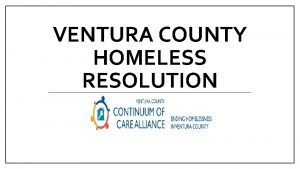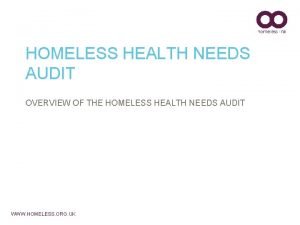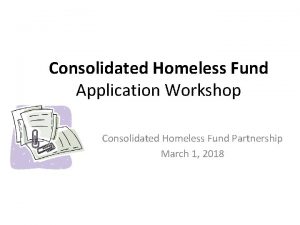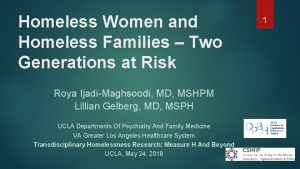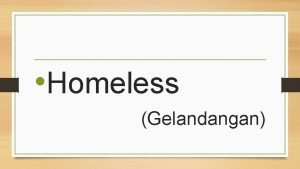HOMELESS CHILDRENS LIFE CYCLE Clayton Chau Eric Handler






























- Slides: 30

HOMELESS CHILDREN’S LIFE CYCLE Clayton Chau

Eric Handler Paul De Leon Karen Muñoz Jeffrey Hernández Alan Albright Mark Refowitz Leia & Dwight Smith

WHAT WE KNOW

FACTS Homeless children were also more residentially unstable; having moved 3. 4 times on average in the past year n 34% of homeless children had been placed in foster care or gone to live with a relative at some point in the past n

FACTS 11. 6% between age 3 months to 17 years had been physically or sexually abused n Lifetime rates of sexual abuse were much higher for homeless youth age 5 -17 (21%) n Weinreb et al. Determinants of health and service use patterns in homeless and low-income housed children. Pediatrics. 1998

HEALTH EFFECTS Poor health for homeless children begin at birth n Poor nutrition and poverty exacerbate illness and disability n Higher rates of ear infections, intestinal infections and respiratory infections n More likely to suffer from chronic illnesses such as cardiac disease, neurological disorders and asthma n Less likely to utilize preventive care n America’s Homeless Children: New Outcasts, Better Homes Fund, 1999

ACADEMIC EFFECTS n n n Approximately two-third performed below grade level in reading and mathematics achievement Homeless children often suffer from delayed speech, language, cognition, social, and motor development, the results of a lack of age-appropriate stimulating exercises Approximately 70% were at moderate or greater risk academically or behaviorally. About 10% of those were at severe risk about 30% of homeless students are functioning within the normal range or have only mild risk factors Ziesemer and Marcoux. Homeless children: Are they different from other low-income children? Social Work, 1994

PSYCHOLOGICAL EFFECTS n n n n 11% of homeless children reported depressive symptoms Older children reported to have more aggressive and acting out behavior than younger children do Mother's distress as strongly associated with reporting greater behavior problems in the child Homeless children are 30% more likely to suffer from drug addiction during adulthood Child behavior problems were above normal levels for homeless children, particularly for antisocial behavior Homeless adolescents did report lower self-worth and more negative perceived academic competence Among homeless children, younger girls appeared to have the most overall behavioral and emotional problems Bassuk et al. Homelessness and Its Relation to the Mental Health and Behavior of Low-Income School-Age Children. Developmental Psychology, 1999 Graham-Bermann et al. Children in Homeless Families: Risks to Mental Health and Development. Journal of Consulting and Clinical Psychology, 1993

HOMELESSNESS = TRAUMA

DEFINITION The experience of multiple, chronic and prolonged, developmentally adverse traumatic events, most often of an interpersonal nature (e. g. , sexual or physical abuse, war, community violence) and early-life onset. These exposures often occur within the child’s caregiving system and include physical, emotional, and educational neglect and child maltreatment beginning in early childhood. Other forms of trauma include chronic exposure to community violence, loss of a primary caregiver in early childhood, loss of home, loss of consistency, etc. Cook et al. , Psychiatric Annals, 2005 Spinazzola et al. , Psychiatric Annals, 2005

CHILDHOOD DEVELOPMENT (AGE 1 -12) Capacity to communicate n Presence of self-concepts and self-awareness n Ability for reasoning (developed capacity to solve new and relatively complex problems) n Morally responsible n

SEVEN DOMAINS OF IMPAIRMENT IN COMPLEX TRAUMA Van der Kolk et al. Disorders of extreme stress; the empirical foundation of complex adaptation to trauma. J Trauma Stress. 2007

Attachment n Biology n Affect regulation n Dissociation n Behavioral control n Cognition n Self-concept n

1. ATTACHMENT Problem with boundaries n Distrust and suspiciousness n Social isolation n Interpersonal difficulties n Difficulty attuning to other people’s emotional states n Difficulty with perspective taking n

2. BIOLOGY Sensorimotor developmental problems n Analgesia n Problems with coordination, balance, body tone n Somatization n Increased medical problems across a wide span (e. g. , pelvic pain, asthma, skin problems, autoimmune disorders, pseudoseizures) n Schore A. Affect Regulation and the Origin of the Self: The Neurobiology of Emotional Development. Hillsdale, NJ: Lawrence Erlbaum Associates; 1994

3. AFFECT REGULATION Difficulty with emotional self-regulation n Difficulty labeling and expressing feelings n Problems knowing and describing internal states n Difficulty communicating wishes and needs n

4. DISSOCIATION Distinct alterations in states of consciousness n Amnesia n Depersonalization and derealization n Two or more distinct states of consciousness n Impaired memory for state-based events n Demitrack et al, Psychiatry Res. , 1993 Van der Kolk BA, Child Adolesc Psychiatr Clin N Am, 2003

5. BEHAVIORAL CONTROL n n n Poor modulation of impulses Self-destructive behavior Aggression toward others Pathological self-soothing behaviors Sleep disturbances Eating disorders Substance abuse Excessive compliance Oppositional behavior Difficulty understanding and complying with rules Reenactment of trauma in behavior or play (e. g. , sexual, aggressive)

6. COGNITION n n n n n Difficulties in attention regulations and executive functioning Lack of sustained curiosity Problems with processing novel information Problems focusing on and completing tasks Problems with object constancy Difficulty planning and anticipating Problems understanding responsibility Learning difficulties Problems with language development Problems with orientation in time and space Shonk and Cicchetti, Dev. Psychopathol. , 2001 Trickett et al, Dev. Psychopathol. , 1994

7. SELF-CONCEPT Lack of a continuous, predictable sense of self n Poor sense of separateness n Disturbances of body images n Low self-esteem n Shame and guilt n

PREVENTIONS/INTERVENTIONS n Psychosocial treatment modalities targeted six core components: safety, self-regulation, self-reflective information processing, traumatic experiences integration, relational engagement, and positive affect enhancement n Parenting skills and educational supports for parents Community centers with programs focused on the above mentioned six components n Complex Trauma Workgroup, National Child Traumatic Stress Network

SAFETY Facilitate and ensure internal and environmental safety

SELF-REGULATION Enhance the capacity to modulate arousal n Restore equilibrium following dysregulation across domains of affect, behavior, physiology and cognition n Expand interpersonal relatedness and selfattribution n

SELF-REFLECTIVE INFORMATION PROCESSING Develop the ability to effectively engage attentional processes and executive functioning n Construct self-narratives n Increase the ability to reflect on past and present experience n Ability to anticipate and plan as well as make appropriate decision n

TRAUMATIC EXPERIENCE INTEGRATION Meaning making n Traumatic memory containment or processing n Remembrance and mourning of the traumatic loss n Symptom management n Healthy coping skills n Cultivate present-oriented thinking and behavior n

RELATIONAL ENGAGEMENT Create therapeutic alliances n Develop critical interpersonal skills such as assertiveness, cooperation, perspectivetaking, boundaries and limit-setting, social empathy, and the capacity for physical and emotional intimacy n

POSITIVE AFFECT ENHANCEMENT Enhance self-worth, esteem and positive selfappraisal through the cultivation of personal creativity, imagination, future orientation, achievement, competence, mastery-seeking, community-building and the capacity to experience pleasure

HOMELESSNESS, A LIFE CYCLE?

FACTS n n Children subjected to various adverse experiences are far more likely to become homeless adults Foster care placement as one of the highest risk factors for later homelessness 35 -43% of homeless mothers were sexually or physically abused as children Homeless children are at a far higher risk of becoming the homeless or even the chronically homeless of the next generation Herman et al. Adverse childhood experiences: Are they Risk Factors for Adult Homelessness? American J of Public Health, 1997 Bassuk et al. Characteristics of Homeless Sheltered Mothers. American J of Public Health, 1986

Q&A
 Dãy núi cao nhất châu á
Dãy núi cao nhất châu á Nguyễn thị cẩm châu
Nguyễn thị cẩm châu Các châu lục và đại dương trên thế giới
Các châu lục và đại dương trên thế giới Dãy núi cao nhất châu á
Dãy núi cao nhất châu á Dãy núi cao nhất châu á
Dãy núi cao nhất châu á Các châu lục và đại dương trên thế giới
Các châu lục và đại dương trên thế giới Nến rơi châu
Nến rơi châu Vẽ tạo dáng và trang trí chậu cảnh
Vẽ tạo dáng và trang trí chậu cảnh Skipton girls' high school
Skipton girls' high school Phan boi chau high school
Phan boi chau high school Bác đang cùng chúng cháu hành quân
Bác đang cùng chúng cháu hành quân Giải phẫu xương chậu
Giải phẫu xương chậu Moli texas children's
Moli texas children's The christian childrens fund
The christian childrens fund Childrens services
Childrens services Walsall childrens services
Walsall childrens services Levine childrens
Levine childrens National sovereignty and childrens day
National sovereignty and childrens day Multi agency assessment
Multi agency assessment Traditional literature quiz
Traditional literature quiz Skeletal system
Skeletal system Longman children's picture dictionary
Longman children's picture dictionary Black childrens memorial
Black childrens memorial Toddler temperature
Toddler temperature History of childrens literature
History of childrens literature Colorado children's book award
Colorado children's book award Mr clark movie
Mr clark movie Disorganized crime scene
Disorganized crime scene James russell odom and james clayton lawson
James russell odom and james clayton lawson Clayton greenberg
Clayton greenberg Clayton atreus
Clayton atreus












